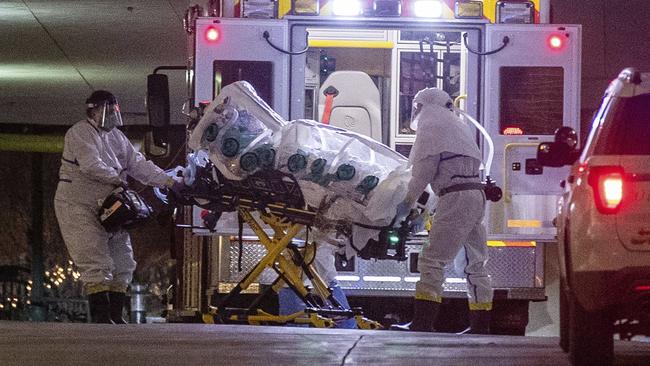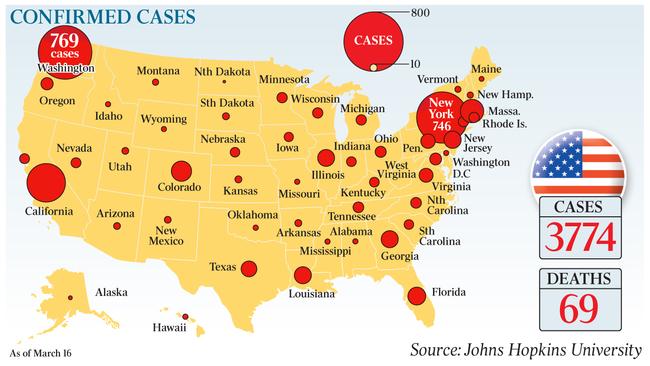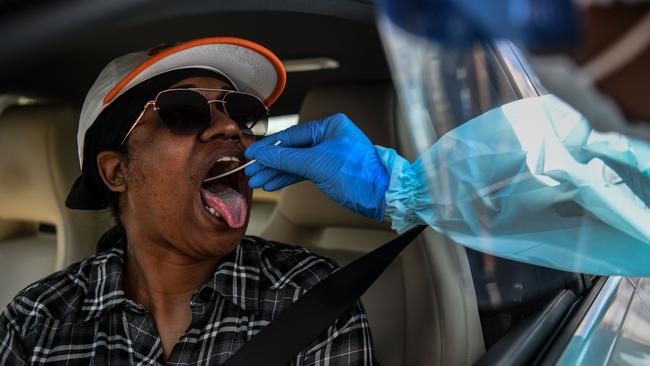Coronavirus: US could be home of the grave as Donald Trump faces criticism
It is becoming apparent the US is woefully unprepared to deal with the surge in cases, and it’s about to see its death toll soar.

My neighbour in Washington DC has been off work for a week with flu-like symptoms, so he called his doctor to ask if he could be tested for coronavirus. The doctor told him there were no testing kits available and that he doubted any would be available for some weeks.
The best course of action, he was advised, was to stay at home and to call again if he had trouble breathing.
This same story is now being played out across the US on an industrial scale as it becomes increasingly apparent the country is woefully unprepared to deal with the surge in COVID-19 cases.
As medical experts pore over modelling for the global spread and death toll from the coronavirus, it is the projections for what potentially awaits the US that are among the most shocking.
The combination of the government’s slow response to the crisis, minimal testing, a dysfunctional health system and a large, mobile population is a recipe for disaster that could soon exceed what has been seen in either China or Italy, experts say.
“The system does not, is not really geared to what we need right now. It’s failing, let’s admit it,” says Anthony Fauci, director of the National Institute of Allergy and Infectious Diseases.
“Americans should be prepared that they are going to have to hunker down significantly more than we as a country are doing. For a while, life is not going to be the way it used to be in the US.”
Experts flying blind
No one knows just how badly the world’s biggest superpower will be hit by the virus because, unlike other Western nations, so few tests have been conducted.
As of Monday (AEDT), the US had recorded 3155 coronavirus cases in 49 of its 50 states, and 62 deaths. But during the first eight weeks of the outbreak, fewer than 20,000 tests have been conducted — a staggeringly low figure for a country of 327 million people.

By comparison, Italy, with 60 million people has conducted more than 60,000 tests, while South Korea, a nation of 51 million, has conducted 235,000 tests and is currently testing at a rate of 10,000 people per day.
In other words, authorities are largely flying blind about the spread of coronavirus in the US, while clearly the prevalence of the disease is far more widespread than official figures suggest.
In the absence of clear information, officials at the US Centres for Disease Control and Prevention last month conferred about what might unfold if coronavirus spread across the US.
As The New York Times reported at the time, under one of the four projections offered, between 160 million and 214 million people could be infected in the US by coronavirus over the course of several months or a year. Of them, between 200,000 and 1.7 million people could die and up to 21 million people in the US would need hospitalisation, completely overwhelming the health system.
Such an apocalyptic prediction is unlikely to come to pass simply because the US is, belatedly, starting to take more extreme steps to combat the spread of the virus. But there is no doubt that the US medical system is poorly prepared for the scale of what is about to hit it.

Equipment shortage
The US has fewer than one million staffed hospital beds, of which only about 100,000 are intensive care beds. Hospital leaders are talking about renting hotels to try to handle the expected overflow of cases.
In particular, the US has a shortage of ventilators, the most crucial instrument to help save the lives of those with coronavirus, a disease that attacks the respiratory system. A study by Johns Hopkins University this year found the US has only 160,000 ventilators, of which 98,000 are basic devices.
“I believe if we have a major outbreak, we are definitely vulnerable to shortages,” says Fauci about the supply of ventilators.
Kenneth Raske, president of the Greater New York Hospital Association, says the US needs to adopt a “World War II mentality, where we’re going to have to put extra shifts on in manufacturing and get this stuff out the door”.
“The only one that can do that is the federal government, and we need both the President and Vice-President to make a priority of that,” he says.
Trump under fire
Donald Trump has been heavily criticised for contributing to the slow US response to COVID-19 by repeatedly playing down the significance of the issue.
Throughout February, his message was that the virus was “totally under control” in the US. As recently as February 26 he predicted that “within a couple of days” the number of infected people “is going to be down close to zero”. Then, when figures started to spike in early March, Trump blamed “the Fake News Media and their partner, the Democrat Party” for “inflaming the coronavirus situation far beyond what the facts would warrant”.
Only in the past week, via his muddled address to the nation and his declaration of a state of emergency, has Trump shown he is now taking the issue seriously, not least because it gravely threatens the US economy and therefore his prospects for re-election.
Even then, when asked about the shortage of testing kits, Trump replied: “I don’t take responsibility at all”, blaming instead a “set of circumstances” and “rules, regulations and specifications from a different time”.
Under fire for the lack of testing, Trump now says the government will partner with private companies to set up drive-through testing sites. He claims that all Americans who need a test will soon get one “very safely, quickly and conveniently”.
But that announcement caught those private companies — including Google, Target, Walmart and CVS — by surprise and they warned that such drive-through tests were still some way from becoming a reality.
No public healthcare
Part of the problem is that the US healthcare system — a privately based, user-pays system vastly different from Australia’s universal healthcare — is not well suited to deal with a major pandemic.
“Healthcare in America is delivered mainly by private for-profit corporations, which, unlike financial institutions, are not required to maintain reserve capacity,” Robert Reich, the labour secretary in the Clinton administration, writes in The Guardian.
“Instead of a public health system, we have a private for-profit system for individuals who are lucky enough to afford it and a rickety social insurance system for people fortunate enough to have a full-time job.
“At their best, both systems respond to the needs of individuals rather than the needs of the public as a whole.
“In America, the word ‘public’ — as in public health, public education or public welfare — means a sum total of individual needs, not the common good.”

Bipartisan deal
Americans’ ability to respond to a pandemic such as coronavirus is also hampered by the absence of safety nets in health insurance, the workplace and childcare.
More than 30 million Americans have no health insurance, and so many of them could not afford to be tested for coronavirus unless those tests were available free of charge.
Almost one in three US workers received no paid sick leave from their employer, including almost 70 per cent of low-income workers. As a result, many of these workers cannot afford to self-isolate, even if they fear they may have symptoms of the virus.
The economic pressure is such that they are more likely to continue to work and risk infecting others simply because they cannot afford to stay at home.
Congress has moved to try to alleviate at least some of these problems with a rare bipartisan deal stitched together between Democrat House Speaker Nancy Pelosi and Treasury Secretary Steven Mnuchin.
The package allows the cost of tests to be covered by insurance and federal government programs. It also includes about $US1bn ($1.63bn) of food programs to supply meals to low-income Americans and it gives some workers two weeks of paid sick leave. However, the deal still excludes almost 20 million workers.

Stockpiling guns
As in Australia, life in the US was turned upside down within a few days last week. Many Americans had been listening to health warnings without altering their lives. But within days, a series of shocks forced even the most sceptical to take notice of COVID-19.
Investors were stunned and rattled by the wildest gyrations seen on Wall Street since the 1987 crash. Sports fans were genuinely shocked by the NBA’s decision to suspend its season, followed quickly by other major sports.
Meanwhile, the news Hollywood megastar Tom Hanks and wife Rita Wilson had tested positive in Australia led the US media coverage and showed how the virus spared no one.
Suddenly every major US event or gathering was cancelled in quick succession — from festivals to conferences, meetings and then finally even Broadway.
At least 15 states including New York have now closed schools, universities and colleges.
Workplaces have emptied as millions of employees work from home, and bars and restaurants, while still open, are mostly sparsely attended.
Like in Australia, supermarket shelves have been stripped of food, medicine and toilet paper as people prepare for possibly weeks of self-isolation.
Pandemic films such as the 2011 movie Contagion and the 1995 film Outbreak are trending on Netflix, while R.E.M.’s song, It’s the End of the World as we Know It, re-entered the top 100 downloaded songs on iTunes.
More disturbingly, gun sales have spiked, with queues around the block at some gun stories as Americans prepare for a possible breakdown of law and order.
In all, the US is closing up in a way that few believed was ever possible as it waits — poorly prepared — for the pandemic that is now spreading across it at ever faster speed.
Cameron Stewart is also US contributor for Sky News Australia.








To join the conversation, please log in. Don't have an account? Register
Join the conversation, you are commenting as Logout